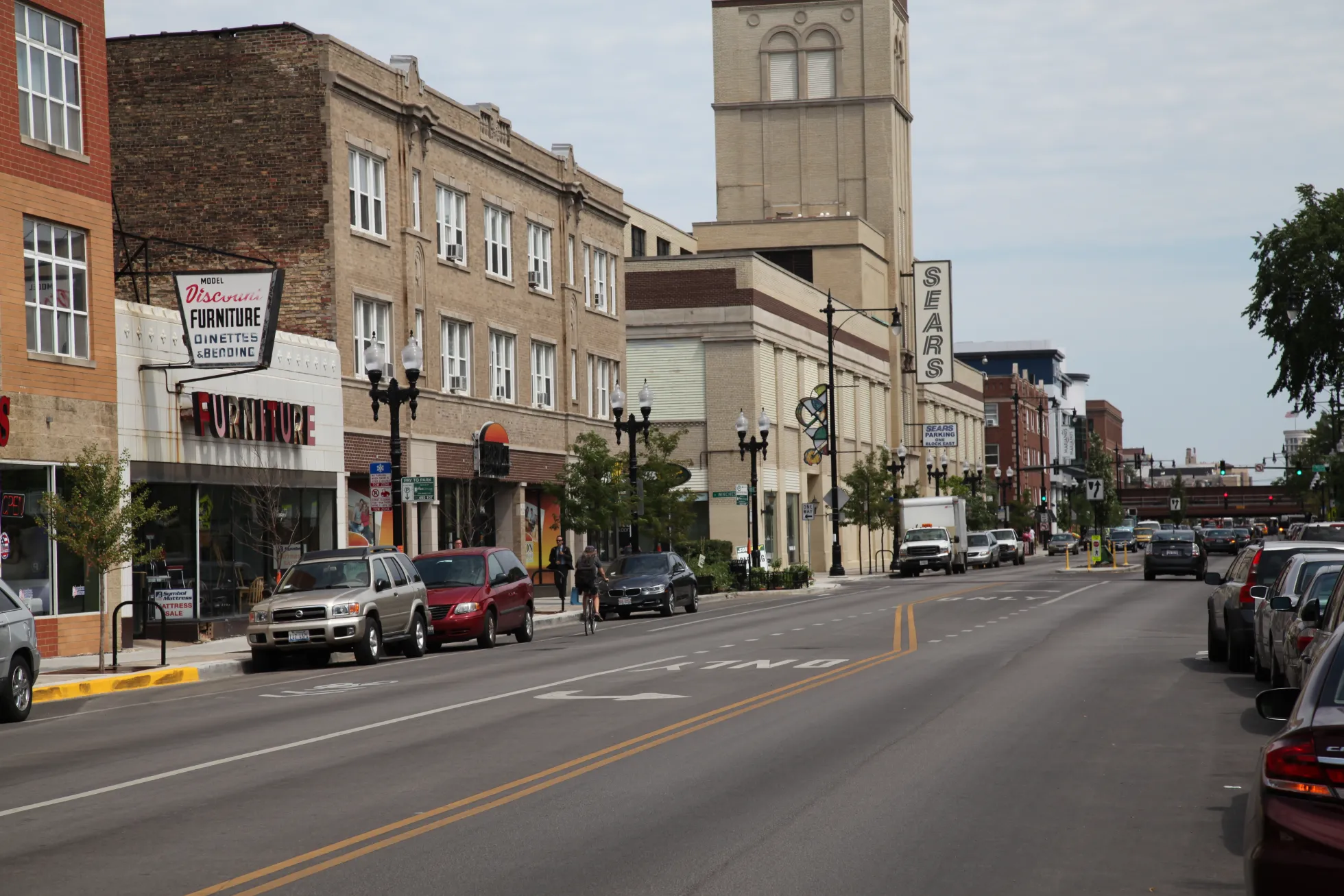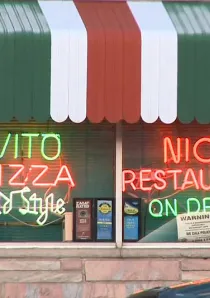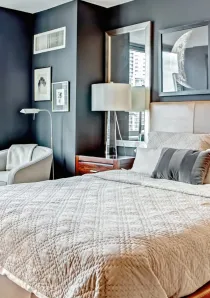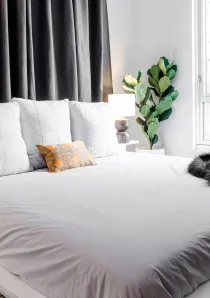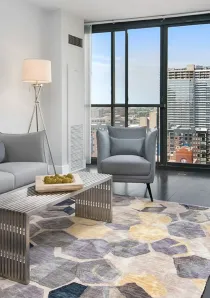The Ultimate Neighborhood Guide
Chicago's vintage furniture scene is a goldmine hiding in plain sight. While tourists crowd Michigan Avenue showrooms, locals know the real design finds lurk in neighborhood shops where history gets a second life as home decor.
The appeal of vintage furniture is immediately obvious when you run your hand across a teak credenza that's survived since the Kennedy administration. These pieces were built during an era when furniture was expected to last generations, not just until the next trend cycle. Solid woods, genuine materials, and proper construction techniques create lasting quality that contemporary knockoffs can't match.
There's also the sustainability factor – rescuing existing furniture keeps perfectly good pieces from landfills while eliminating the environmental impact of new production. Your vintage find comes with a clear conscience built right in. Most compelling, though, is how these pieces bring authentic character to Chicago homes. That Art Deco vanity witnessed morning routines during the Great Depression. The industrial filing cabinet organized papers for a bygone Chicago business. In each scratch and patina lies evidence of lives lived alongside these objects.
These stories aren't confined to the city limits, either. In nearby Algonquin, My Best Friend’s Closet—a consignment and thrift shop recently highlighted by CBS News—has become a haven for affordable vintage treasures. What started as a personal project blossomed into a full-fledged resale destination where shoppers score unique home goods while supporting a family-run business. It’s a reminder that some of the region’s most heartfelt vintage finds come from unexpected places—and often carry stories just as rich as the furniture itself.
Fortunately, each neighborhood brings its own flavor to the vintage furniture experience, so whatever you’re looking for, you’re liable to find it. Andersonville showcases pristine mid-century pieces with eye-watering price tags, while Pilsen warehouses hide affordable industrial gems among the dust. The hunting grounds shift dramatically depending on your budget, style preferences, and willingness to get your hands dirty.
In this neighborhood-by-neighborhood guide, we will walk you through Chicago's furniture hunting grounds, from designer showrooms to dusty warehouses. We'll explore each area's unique offerings, share restoration resources, and offer shopping strategies that will forever change how you view furnishing your Chicago home.
North Side Furniture Hunting: Design Classics to Bargain Discoveries
Andersonville: Nordic Legacy in Every Detail
Andersonville delivers a furniture experience as Swedish as its street signs. This Clark Street corridor has transformed into the city's nucleus for vintage design enthusiasts seeking authenticated pieces with complete histories and exceptional preservation.
Walking the neighborhood reveals a distinctly Nordic aesthetic – minimalist silhouettes, honeyed woods, and purposeful design that defined Scandinavian modernism long before international chains brought diluted versions to the masses. These storefronts showcase authentic pieces from design's golden era when craftsmanship wasn't a marketing term but a standard expectation.
The investment required here reflects the caliber of merchandise. Dining ensembles by recognized designers start in four-figure territory, while significant collectible pieces can reach well into five figures. More accessible options exist through smaller objects – lighting fixtures, decorative ceramics, and textiles ranging from $75-400 that provide entry points into vintage collecting.
Scout (5221 N Clark St) displays an impeccably chosen selection that spans from mid-century classics to industrial artifacts. Their thoughtfully arranged two-level space suggests how pieces might integrate into contemporary living. Their sterling reputation stems from authenticity verification that justifies higher price points.
Andersonville Antiques (5245 N Clark St) is a longtime neighborhood staple where vintage meets variety. This multi-dealer collective spans two levels, offering everything from mid-century coffee tables and deco lamps to vintage barware and quirky curios. The layout invites slow wandering, with each booth reflecting a different seller’s taste and era of expertise. Prices range from accessible to splurge-worthy, but the real draw is the thrill of discovery—this is the kind of place where you come for a side table and leave with a brass flamingo and a newfound obsession.
Woolly Mammoth (1513 W Foster Ave) isn’t your typical vintage shop—it’s more like a curated cabinet of curiosities for the delightfully strange. Taxidermy, antique medical tools, faded photographs, and other oddities fill this tightly packed storefront, where furniture often takes a backseat to atmosphere. But for the right kind of decorator—one who sees beauty in the bizarre—it’s a goldmine. You probably won’t leave with a dining set, but you might find the perfect anatomical chart or apothecary cabinet to anchor a room with character.
Ravenswood & Lincoln Square: Reclaiming History Piece by Piece
Moving westward into Ravenswood and Lincoln Square reveals a dramatically different vintage landscape centered on architectural elements, industrial components, and furniture awaiting imaginative reinterpretation.
The manufacturing legacy of Ravenswood's warehouse district permeates its furniture offerings, prioritizing substance alongside style. These establishments house fewer showroom-ready arrangements and more character-rich components bearing their histories openly – converted factory storage units, institutional furniture repurposed for residential use, and architectural fragments ready for reimagining.
Midwestern Arts & Antiques (4648 N Western Ave) is a low-key Lincoln Square fixture where traditional antiques take center stage. The focus here is old-world elegance—ornate mirrors, carved wood furniture, oil portraits, and vintage chandeliers that feel plucked from a grandparent’s parlor in the best possible way. It’s not trying to be trendy, which makes the finds feel even more timeless. The shop’s layered layout invites slow wandering, and prices tend to favor collectors over casual browsers—but deals surface if you know what you’re looking at.
For practicality-minded shoppers, District (4835 N Damen Ave) concentrates on mid-century selections refurbished specifically for contemporary lifestyles. Their inventory emphasizes everyday usability over collector status, featuring pieces ready for immediate integration without additional restoration requirements.
Edgewater & Rogers Park: Authentic Finds Without Pretense
Venture into Edgewater and Rogers Park to discover Chicago's last frontier of unfiltered furniture hunting. These neighborhoods haven't gotten the memo about "curated vintage experiences" or "investment-grade collectibles" – and thank goodness for that.
While Andersonville shops might arrange furniture like museum displays, Rogers Park thrift stores pile it high and let the digging be part of the fun. This is where dedicated bargain hunters score genuine mid-century pieces for IKEA prices, simply because the shops don't cater to collectors who know exactly what they're looking at.
But the unpolished charm of the North Side doesn’t stop there. Stretch a little west or north, and you’ll find shops that expand the definition of vintage—whether it's a curiosity-packed gallery in Irving Park, a dense antique trove in Andersonville, or a wood-rich haven in Evanston. These spots share a common thread: they prioritize character, substance, and discovery over showroom gloss.
Bringing home treasures from these neighborhoods means being ready to spot potential beneath the dust. That neglected teak side table might just need some oil and love. Those stackable school chairs from the 1960s could be the conversation-starting dining set you've been hunting for. The vibe is less precious, more practical—and often far more interesting.
Lost Eras (1511 W Howard St) creates an immersive historical experience through its densely packed, multi-era inventory without rigid categorization. What initially appears overwhelming rewards thorough investigation, as valuable discoveries often lie beneath surface impressions.
Andy’s Art Antiques & Oddities (3924 W Montrose Ave) lives up to its name with a mix of the beautiful, the bizarre, and the just plain cool. This Irving Park shop blends antique furniture with vintage artwork, taxidermy, religious relics, and curios you won’t find anywhere else. It’s part gallery, part cabinet of curiosities, and entirely unpredictable. If your idea of good design includes a side of mystery, Andy’s delivers.
Evanstonia Antiques & Restoration (703 Main St, Evanston) specializes in furniture with history and heft. This longtime shop focuses on American and European antiques—mahogany sideboards, carved armoires, vintage lighting—and offers expert restoration for pieces that need new life. The vibe is classic, not trendy, and the staff knows their stuff. Come for the craftsmanship; stay for the stories behind the woodwork.
Brownstone Antiques (5234 N Clark St) is a Clark Street mainstay that embraces the beauty of organized chaos. The space is packed from floor to ceiling with everything from Victorian mirrors and mid-century glassware to oil paintings, clocks, and the occasional oddity. It’s not precious or over-styled—just a solid spot for treasure hunters who enjoy the thrill of the dig. Prices vary, but patience usually pays off.
West Side Furniture Destinations: Industrial Heritage Meets Artistic Vision
West Town & Ukrainian Village: Loft-Ready Industrial Treasures
West Town and Ukrainian Village have emerged as the epicenter of Chicago's industrial vintage movement, where the neighborhood's manufacturing past lives on through repurposed furnishings. These former factory districts now host showrooms where metal meets wood in pieces designed for the area's converted loft spaces and industrial-inspired homes.
The aesthetic here skews unapologetically industrial, with raw steel surfaces, weathered wood, mechanical components, and pieces that celebrate rather than conceal their utilitarian origins. This is furniture with an honest history, where function inspired form long before it became a design trend.
Vintage Quest (4845 N Damen Ave) feels like stepping into a time capsule curated by someone with equal love for nostalgia and quality. Tucked just off the Brown Line, this shop leans into Americana—vintage radios, 1950s kitchenware, classic advertising, and the kind of wood furniture built to survive a few lifetimes. It’s not trying to be trendy, and that’s exactly the point. The owner knows every item’s backstory, and it shows in the thoughtful displays and fair pricing. If you're after pieces with charm, memory, and zero pretension, this spot delivers.
Warehouse 55 (1819 W Grand Ave) delivers vintage with polish and punch. Housed in a sprawling warehouse in West Town, this multi-dealer collective blends mid-century staples, industrial pieces, and glam touches with just the right amount of edge. You’ll stumble across velvet sofas, brass bar carts, lucite chairs, and quirky statement art—all styled like a photoshoot but still priced for real homes. It’s a favorite for designers and bold decorators looking to make a room unforgettable.
The Golden Triangle (330 N Clark St) is where vintage goes global. Specializing in Asian and European antiques with a focus on statement pieces, this River North showroom feels more like a design destination than a typical shop. Oversized teak cabinets, hand-carved screens, and rare architectural elements fill the sprawling space, each piece chosen with a collector’s eye. It’s high-end, no doubt—but if you’re looking for furniture that transforms a room and tells a story, this is where you go when you're done playing it safe.
Dial M for Modern (2621 W North Ave) specializes in accessible mid-century furniture with a focus on livable pieces rather than investment-grade collectibles. Their approachable pricing and refreshingly unpretentious atmosphere make vintage design accessible to younger homeowners and first-time collectors. Unlike shops that treat furniture as precious artifacts, they encourage customers to mix eras and styles according to personal taste.
Salvage One (1840 W Hubbard St) transcends ordinary furniture shopping to create an immersive experience spanning three floors of a former warehouse. Beyond traditional furniture, they stock architectural elements, commercial fixtures, and industrial components that creative homeowners transform into distinctive furnishings. Their upper floors house items organized by material and era, while the main floor showcases fully restored signature pieces ready for their next life.
Logan Square & Avondale: Creative Eclecticism and Artistic Vision
Follow Milwaukee Ave through Logan Square and Avondale, and you’ll hit one of the city’s most eclectic vintage stretches. These neighborhoods favor instinct over perfection—shops here don’t chase trends or obsess over provenance. Instead, they offer color, character, and furniture that feels genuinely lived-in (in a good way).
This is where you find a velvet chair that looks like it belonged in a ‘70s film set—or a chrome coffee table that somehow just works. Prices tend to be fair, especially if you’re open to a little wear and a lot of personality. No velvet ropes, no attitude—just good pieces waiting for the right home.
Three Stars Vintage (2882 N Milwaukee Ave) keeps it fun and unfussy with a bright, approachable space full of mid-century finds, bold decor, and the kind of pieces that instantly add personality to a room. Inventory runs from the 1950s through the '90s—formica tables, chrome-legged chairs, funky lamps, and framed art with serious throwback energy. Prices are reasonable, turnover is fast, and the vibe is more “cool older cousin’s apartment” than showroom.
Vintage Frills (2846 N Milwaukee Ave) brings a softer side to the vintage scene with a flair for the romantic and the offbeat. The space is small but packed with charm—floral armchairs, dainty dressers, and more chandeliers than you'd expect in a storefront this size. The style leans feminine and cottagecore without tipping into kitsch, and the pieces often feel like they were pulled straight from a dreamy 1970s apartment. It’s an easy stop if you're hunting for furniture with character and a little bit of sweetness.
Pino Viejo Rustic Furniture (3383 N Milwaukee Ave) is all about substance over flash. This family-run shop in Avondale builds solid pine furniture with a rugged, handcrafted feel—chunky tables, heavy armoires, and storage pieces that look like they’ve already lived a few good decades. Designs lean rustic with Mexican and Southwestern influences, and most items can be custom-sized or stained to fit your space. Prices are fair, and everything’s made to last—no particleboard in sight.
South Side Vintage Treasures: Cultural Mashups and Academic Gems
Pilsen & Bridgeport: Art-Fueled Furniture Revolution
Pilsen and Bridgeport flip the vintage furniture script entirely. These aren't stuffy showrooms with "do not touch" signs – they're creative laboratories where furniture becomes cultural expression. Wander through these neighborhoods, and you'll find vintage pieces transformed by the same artistic energy that covers building walls with murals and turns industrial spaces into galleries.
In Pilsen, Mexican heritage infuses everything. That plain 1960s dresser? Now it sports hand-painted drawer fronts inspired by Frida Kahlo. The simple wooden dining set? Reimagined with vibrant textiles that would make your Pottery Barn-shopping friends weep with envy. This isn't preservation for preservation's sake – it's furniture with something to say.
Pilsen Vintage (1430 W 18th St) feels more like a creative collective than a furniture shop. The inventory changes constantly as local artists collaborate on transforming solid vintage frames into conversation-starting statement pieces. The shop runs on a refreshingly straightforward philosophy: find well-built pieces with good bones, then make them impossible to ignore.
El Anticuario (1425 W 18th St) in Pilsen is more than an antique store—it's an immersive journey through time and culture. Curated by Francisco Orozco and his family, the shop offers an eclectic mix of vintage items, Latin American literature, statues, and artifacts, each with its own story. On weekends, co-owner Alex Orozco shares homemade baked goods, adding a personal touch that transforms browsing into a communal experience. Whether you're seeking a rare book or simply soaking in the nostalgic atmosphere, El Anticuario invites you to explore and connect with the past in a uniquely personal way.
No Telling Vintage (1444 W Chicago Ave) feels like a curated mixtape of eras and styles, with furniture, home goods, and clothing all sharing the same bold, confident energy. The space is small but well-composed—no filler, no fluff. Expect sculptural chairs, sharp-lined case goods, brutalist lamps, and the occasional wild card piece that somehow works. Everything feels handpicked with purpose, and the owners clearly have a sharp eye for statement design.
Bridgeport's Zap Props (3611 S Loomis Pl) breaks every rule in the vintage furniture handbook. This massive warehouse sprawls with decades of American design organized by era rather than function. One moment, you're sitting in a 1950s diner booth; the next, you're testing an art deco vanity. The theatrical flair makes sense once you learn that movie productions and photographers regularly mine this collection for authentic period pieces. The difference? You can actually buy what you fall in love with.
The Big Box vs. Hidden Gem Showdown
Chicago's furniture scene isn't just divided by neighborhood boundaries – it's split between radically different business models that shape your shopping experience from the moment you walk through the door. Understanding these differences saves time and spares disappointment when hunting vintage treasures.
The Volume Players: Chain Thrift Stores
The Brown Elephant locations across the city offer the closest thing to furniture gambling in Chicago. On any given day, you might score a pristine mid-century nightstand someone donated without researching its value, or you might wade through endless particleboard casualties. Their Andersonville location (5404 N Clark) typically houses the best furniture selection, benefiting from neighborhood turnover and space for larger pieces.
What makes these stores worth visiting is their unpredictability. Unlike curated shops that price according to current design trends, chain thrift stores often miss the significance of what crosses their donation threshold. That Danish modern teak dining set might be priced based on "table plus chairs" rather than designer pedigree. These pricing disconnects create legitimate bargains for knowledgeable shoppers.
Habitat for Humanity ReStores flip the typical thrift model by specializing in building materials and furniture basics. Their Oak Lawn location (3301 W Columbus Ave) stands out for solid wood bookcases, sturdy tables, and functional storage pieces – furniture built when quality construction was standard rather than premium. These stores excel at practical pieces rather than design classics, making them perfect for furnishing first apartments or outfitting workshops.
The chain thrift experience requires frequent visits and quick decision-making. Quality pieces disappear within hours of hitting the floor, creating an early-bird advantage for regular shoppers. The most successful hunters check in weekly, developing relationships with staff who occasionally provide tips about incoming items before they reach the sales floor.
Curator's Collections: Specialty Boutiques
At the opposite end of the spectrum, boutique dealers create highly selective environments where every piece meets exacting standards before display. These aren't places to stumble upon accidental bargains – you're paying for expertise, authentication, and the owner's discriminating eye.
The boutique approach rewards shoppers seeking specific pieces rather than general browsing. These establishments excel at connecting discriminating buyers with exactly what they need, often providing provenance details, condition reports, and design history that contextualize each purchase. The higher prices reflect not just the objects themselves but the expertise and curatorial judgment that prevents wasted time sorting through lesser examples.
The smart furniture hunter develops relationships across both models, using chain stores for unexpected bargains while relying on boutiques for investment pieces worthy of passing to the next generation.
The Price Tag Dance: Decoding Furniture Values
Chicago's vintage furniture market operates on unwritten rules that mystify newcomers while rewarding insiders. Whether you're buying treasures or clearing space, understanding how dealers value and negotiate pieces transforms the experience from intimidating to empowering.
The Science and Art of Vintage Pricing
Pricing vintage furniture blends objective factors with market psychology. Dealers consider construction quality, designer attribution, condition, rarity, and current trend alignment when setting tags. That unmarked teak credenza priced at $1,200 isn't arbitrary – it reflects solid construction, intact original hardware, and market demand for mid-century storage pieces.
Original manufacturer's marks dramatically impact value. A table bearing Herman Miller, Knoll, or Dunbar labels commands significantly higher prices than visually identical unmarked pieces. Savvy shoppers learn to recognize distinctive construction methods and hardware that identify unmarked designer pieces overlooked by less knowledgeable dealers.
Different districts operate on distinct pricing philosophies. Andersonville and River North dealers typically price at full market value with minimal negotiation expected. West Town and Pilsen shops often build modest negotiation margins into their tags. Suburban estate sales price according to systematic reduction schedules, with predictable percentage drops on successive days.
Negotiation Realities: What Works and What Fails
Effective negotiation begins with understanding when flexibility exists. High-end showrooms with investment-grade pieces rarely budge on documented designer items but might accommodate on supplementary pieces. Volume-focused stores build negotiation margins into most items except recent arrivals.
The most successful approach combines respectful curiosity with legitimate considerations. Questions about item history create conversation openings, while genuine condition issues provide negotiation leverage. "I love this piece but noticed the drawer runner needs repair – would you consider $800 instead of $950?" acknowledges value while presenting reasonable adjustments.
Bundling multiple purchases creates powerful negotiation opportunities. Dealers face storage constraints and inventory turnover pressures that make package deals attractive. Committing to that sideboard, coffee table, and lamp as a set typically yields better discounts than attempting to negotiate each piece individually.
Cash remains king in many vintage shops, particularly smaller operations and market vendors. Physical currency eliminates processing fees and creates immediate liquidity that many dealers value enough to offer 5-15% discounts. Even shops with sophisticated point-of-sale systems often maintain separate pricing structures for cash transactions.
For Sellers: Getting Fair Value
When clearing your own vintage pieces, matching items to appropriate venues maximizes returns. Designer pieces with documentation achieve the highest values through consignment at specialized dealers like Modern Cooperative or Scout, where knowledgeable shoppers willingly pay premium prices for authenticated items.
Practical furniture without significant collectible value fares better through direct sale platforms like Facebook Marketplace, where eliminating dealer markup creates attractive pricing for buyers while maximizing seller returns. When evaluating dealer purchase offers, understand that they typically need to double their investment to maintain viable business models.
Photography profoundly impacts selling success. Well-lit images capturing distinctive details and accurate conditions dramatically improve response rates and perceived value. Documenting any maker's marks, model numbers, or labels provides crucial authentication that justifies higher asking prices.
The vintage furniture market rewards knowledge above all else. Whether buying or selling, investing time in understanding what makes particular eras, designers, and construction methods valuable transforms random shopping into strategic acquisition of pieces that hold or appreciate in value while bringing a distinctive character to Chicago's apartments and homes.
Beyond Mere Furniture: Finding Stories Worth Keeping
Chicago's vintage furniture scene offers more than just places to sit and surfaces to eat from – it connects us to the city's design heritage through pieces built when craftsmanship mattered and disposability wasn't an option. Each neighborhood's shops reflect the cultural DNA of their communities, so if you’re moving to Chicago, the best thing you can do is explore! To learn more about each different spot in our amazing city, check out our neighborhood guides.
The next time you need to furnish your Chicago apartment, consider skipping the assembly-required big box options. Instead, explore these neighborhood shops where furniture carries stories worth continuing in your own space. That mid-century coffee table might have witnessed decades of conversations before anchoring your living room. That industrial shelving unit could have organized factory tools before displaying your book collection.
Have you discovered a hidden furniture gem in your Chicago neighborhood? Share your vintage victories and shop recommendations with us at Domu – we're always looking for the next great find to share with our apartment-hunting community!

